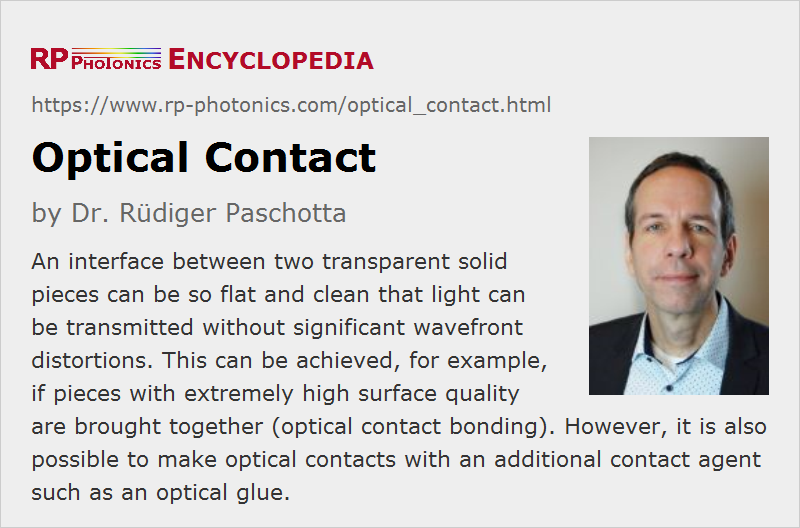Optical Contact
Definition: a close and clean contact between two solids where light can be transmitted without significant wavefront distortions
German: optischer Kontakt
Author: Dr. Rüdiger Paschotta
Cite the article using its DOI: https://doi.org/10.61835/oxr
Get citation code: Endnote (RIS) BibTex plain textHTML
When two transparent solids, e.g. pieces of an optical glass, are brought together, the optical properties of the contact region depend on the microscopic quality of the surfaces. Surface irregularities, even on a sub-micrometer scale, can lead to substantial wavefront distortions for light passing the interface, and also scattering of light in random directions. Furthermore, even a tiny air gap between the solids causes reflections at the then two interfaces, and reflected light from both interfaces easily causes interference effects – for example, visible interference fringes in reflected and/or transmitted light. Such effects are often highly disturbing for applications and thus often need to be largely suppressed in optical technology, e.g. for imaging applications and for preserving the beam quality of laser beams.
An optical contact is meant to be an interface where the optical properties are close to perfect, i.e., without significant deviations from a perfectly clean and flat interface. Such a contact can actually also occur on an interface between a solid and a liquid.
Methods for Achieving Optical Contacts
Optical Contact Bonding
One way of achieving an optical contact is optical contact bonding. This means that a near perfect interface on a nanometer scale is achieved by extremely high quality polishing and cleaning. If two pieces with such surface qualities are brought into contact, they will naturally bond, i.e., merge to a single part so that they can hardly be separated anymore. See the article on optical contact bonding for more details.
Using an Adhesive
Similarly good optical properties can also be achieved without reaching such perfect surface qualities. In particular, an optical adhesive (optical glue) may make some moderate level of surface irregularities irrelevant, particularly if the refractive index well matches that of the media on both sides.
Particularly if the surface irregularities are far smaller than one optical wavelength, minimal disturbances of the optical phase result, and close to perfect optical properties are obtained, even in short-wavelength regions such as the ultraviolet. If the refractive index is well matched, larger mechanical irregularities can be tolerated. Of course, it is vital that no air bubbles are formed when making the optical contact, since the large refractive index contrast between air and the optical materials would cause strong scattering of light.
Different materials are used as optical adhesives, depending on the particular requirements of the application. A typical choice are single-component UV-curable adhesives, while others can be cured (solidified) by application of an increased temperature for some period of time. Usually, some kind of polymerization is involved in the curing process. Of course, high transparency and high homogeneity as well as long-term stability are important qualities of optical adhesives.
The application of adhesives can have a number of disadvantages, such as
- the risk of introducing bubbles of air during the application
- chemical dissociation of the glue caused by non-ideal ambient conditions, leading to increased absorption (e.g. blue absorption by polyurethane, leading to a yellow color)
- a limited temperature range with full stability
- outgassing of organic substances e.g. in a vacuum chamber
- reduced threshold of laser-induced damage
Therefore, a good choice of an adhesive suitable for a particular application can be vital, and also the correct application of it. As details like the exact chemical composition are often not revealed by manufacturers (and hard to analyze), there may also be challenges when replacing one product by another, or if product quality of one manufacturer changes.
Index Matching Fluids
Similar to an adhesive, an index matching fluid (e.g. a silicone oil) can adapt to a somewhat irregular solid surface, allowing for a good optical contact without reaching very high surface quality. Again, it is important that the refractive index is well matched to that of the solid piece.
The key difference to an adhesive is that the viscosity of an index matching fluid is low and remains low, allowing one to remove the liquid later on. (Completely removing it may take additional steps, such as applying a solvent.)
See the article on index matching fluids for more details.
Examples for Application of Optical Contacts
Some typical examples are:
- There are compound prisms, formed by bonding (cementing) two prisms together – with or without an adhesive.
- Achromatic lenses generally consist of two lenses from different materials which are bonded together. Generally, the interface is curved.
- Dielectric coatings usually have an optical contact with their substrate.
- A contact lens on an eye also form an optical contact.
More to Learn
Encyclopedia articles:
Bibliography
| [1] | Lord Rayleigh, “Optical contact”, Nature 139, 781 (1937); https://doi.org/10.1038/139781a0 |
Questions and Comments from Users
Here you can submit questions and comments. As far as they get accepted by the author, they will appear above this paragraph together with the author’s answer. The author will decide on acceptance based on certain criteria. Essentially, the issue must be of sufficiently broad interest.
Please do not enter personal data here. (See also our privacy declaration.) If you wish to receive personal feedback or consultancy from the author, please contact him, e.g. via e-mail.
By submitting the information, you give your consent to the potential publication of your inputs on our website according to our rules. (If you later retract your consent, we will delete those inputs.) As your inputs are first reviewed by the author, they may be published with some delay.

 general optics
general optics
Connect and share this with your network:
Follow our specific LinkedIn pages for more insights and updates: